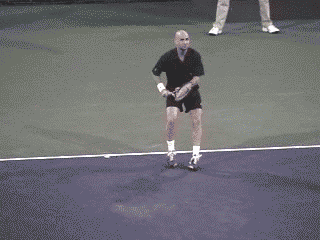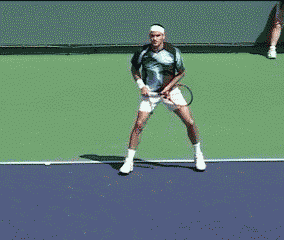|
TennisOne Lessons Racquet Speed – Lagging is the Key Jim McLennan Our wonderful game continues to evolve. Newsreel footage of the 40’s and 50’s show a deliberate game played mostly from the baseline, where often the strokes looked as unusual as the outfits. Rod Laver and others ushered in the (then) modern net rushing game, with much more athleticism and many more playing an “all court” game. As Lendl and others heralded the initial stages of the modern power game in the 1980’s, baseline play returned to prominence, as the ground strokes became ever more powerful and deadly. Even though Pete Sampras continued to exhibit his all court skills, in the main, the game as we know it today concerns racquet speed, power from all corners of the court, topspin ground strokes much more often than crisp net court play (Henman and Dent have retired), and actually racquet strings that slightly deaden the power and give the players ever more control. But from the 60’s and 70’s, where players were taught about balance, shift of weight, and strokes with deliberate preparation and long follow-through (remember, the sweet spots were much smaller), the oft heard phrase from that era still rattles around the courts – “Racquet back, get the racquet back early!”
However, as we transition to this more modern racquet speed model, it appears the exact opposite is done by our men and women professionals: Their initial preparation involves a turn to the side but a significant delay in the “taking back of the racquet.” In fact, former Wimbledon champion Stan Smith put this issue in clear perspective at a conference some years ago when he said, “In my day you pointed the racquet to the back fence and finished with the racquet pointing to the front fence, but now we prepare with the racquet pointing to the front fence and finish with the racquet pointing to the back fence." Somehow, many players feel and or believe that to create more racquet head speed they need longer and longer swings. But a page from Barry Bonds and Andre Agassi reveal just the opposite: both were known for compact yet incredibly quick swings. Stated again, short, quick, powerful swings. And the secret was and will be the “lag.”
As Agassi and Bonds explode into the ball, the hands pull on the handle, but the racquet head (or bag) actually delays, lags behind, then catches up in a whipping motion at impact. Note the lagging racquet head picks up speed at impact, with a short yet somehow loose motion. Not a big backswing, not an enormous follow-through, but serious racquet head speed at impact. Feeling the Lag - The 8-Board So the 8-board, developed by Jack Broudy (also a TennisOne writer), has been a real eye opener for me, and for many of our students.The 8-Board is an excellent teaching tool for players who are overly tight, or uncommonly stuck on getting the racquet way too far back without reference to the incoming ball. Their swings (and rhythm) is often one in which the racquet wags much like a dog at its tail. So Old School McLennan when first using the 8-Board was critiqued for “the tail wagging the dog.” And after a little demonstration by Jack (he showed me I was initiating the back and forth motion of the racquet by using my arms rather than my trunk, and that were the arm and racquet a “tail”) I realized I was actually using the tail to wag the dog. Note at this point I had played tennis for nearly 40 years and had never, repeat never, heard such an analogy. He then demonstrated a lagging motion both in preparation and forward-swing, a dog wagging its tail motion, that was shorter, more fluid. The racquet was in the hitting zone much longer, and darn it the swing looked just like Agassi (and countless others). Racquet speed - the racquet began pointing to the front fence and finished pointing to the back fence, but from flow and release rather than muscles and force. Consider riding a bicycle, how it feels to find the balance, the rhythm, turning, stopping and starting. Probably we can all do this reasonably well, but few could really describe these tasks to another who had not ridden a bicycle. I think the same goes for the rhythm of the lagging swing. Teachers, including myself, may labor with the mechanical intricacies, but in the end the doing is simply in the “feeling.” And on that score, watch the Agassi backhand again and again until you can see the subtle lag just at the moment of the forward swing. Study the Federer forehand as he pulls the racquet head into the hit. The racquet head appears to lag well behind until it explodes into the ball. Or study Andy Roddick as he prepares with his shoulders well turned, his arm drawn back, but the racquet head still pointing forward. This is not racquet back early and pointing to the back fence. This is not swinging deliberately into the ball. And this is not following through until the racquet points to the front fence. And aside from considerably more racquet speed, the racquet head actually stays much closer to the hitting zone during preparation, which totally simplifies timing.
Practicing the Lag The topspin, No-Man’s land, half-volley actually captures the feel of this stroke. Two years ago in the Wimbledon final, Nadal rifled a ball to the baseline, where Federer ever so gracefully whipped a topspin forehand half-volley, not a winner, but simply a controlled reply. The TV crew played and replayed the clip, while the announcers marveled at the timing and simplicity of the stroke. But on closer inspection one would note that Roger had not drawn the racquet back, but turned to the forehand side, the racquet seemingly suspended in the hitting zone, and then a turn into the hit with the racquet lagging at impact. You can try the same using a practice partner or ball machine, where a fast incoming shot lands at your feet, and the trick is to lag the racquet in the contact zone both during preparation and the forward swing, such that a seemingly impossible shot is timed to perfection. Note, this shot is impossible when the racquet starts pointing at the back fence and finishes pointing at the front fence. But with repeated practice and diligence to understand and perfect your timing, you will find a more powerful version of this lagging stroke occurring on your forehand and backhand side. Your comments are welcome. Let us know what you think about Jim McLennan's article by emailing us here at TennisOne.
|
||||||||||||




